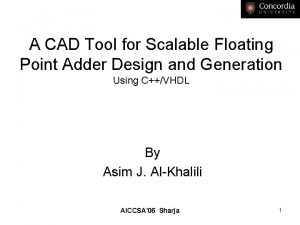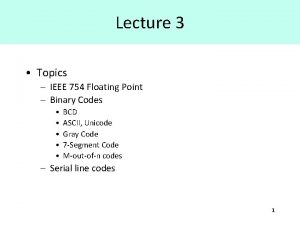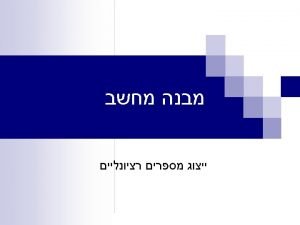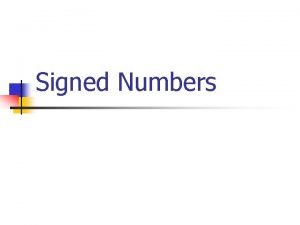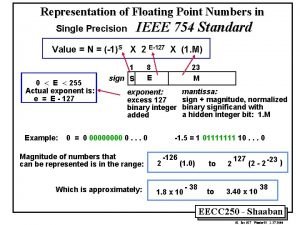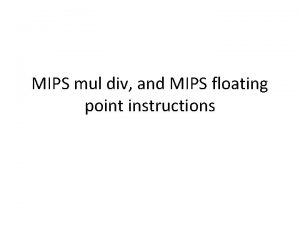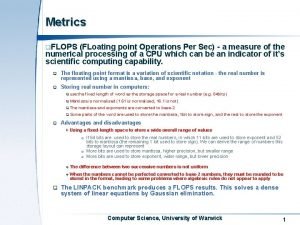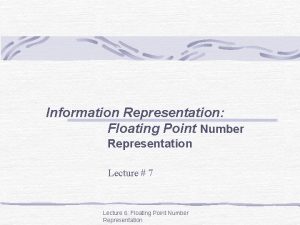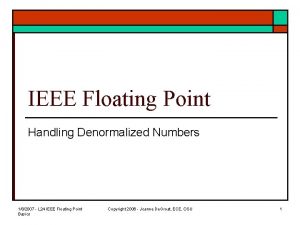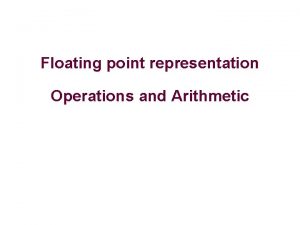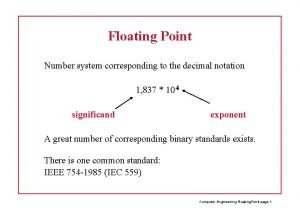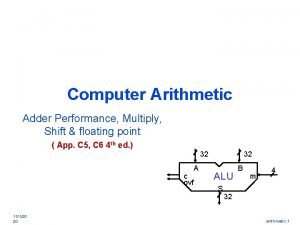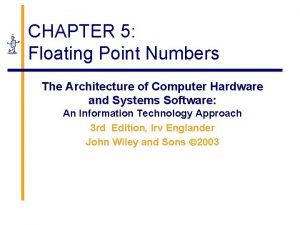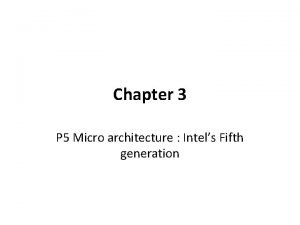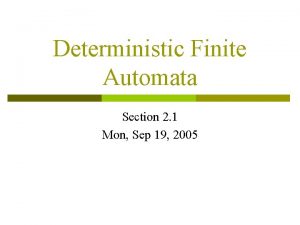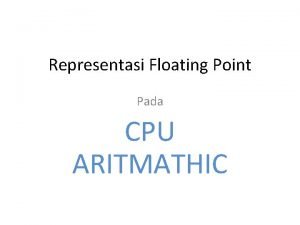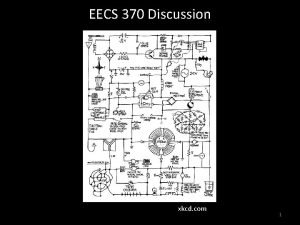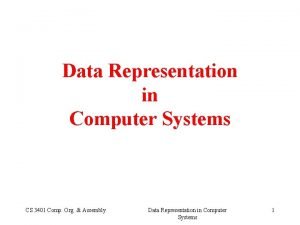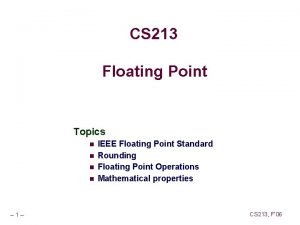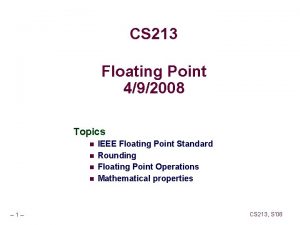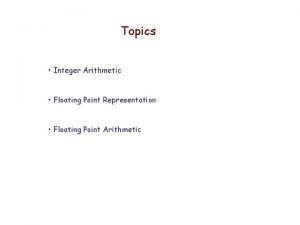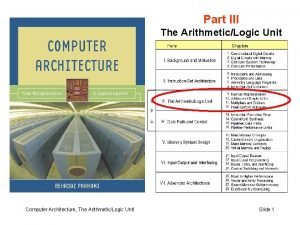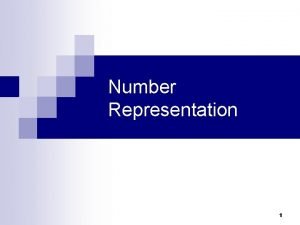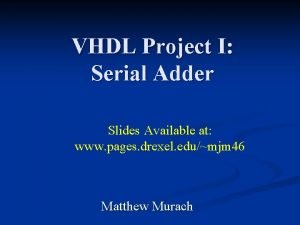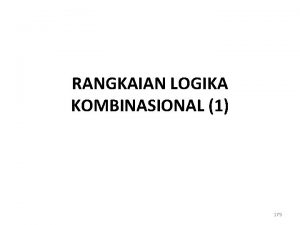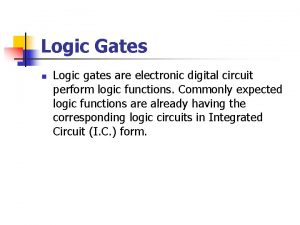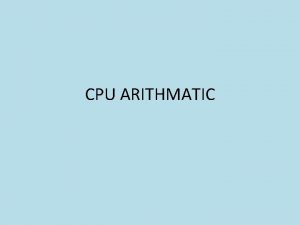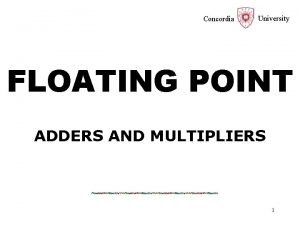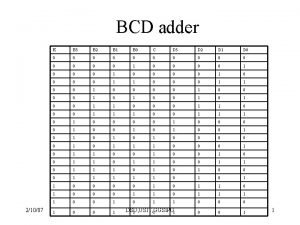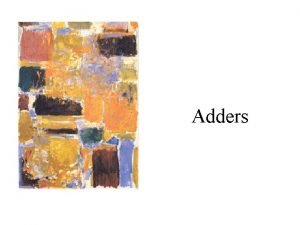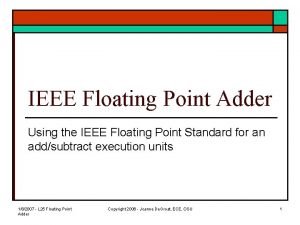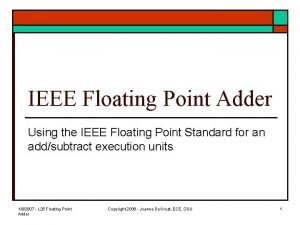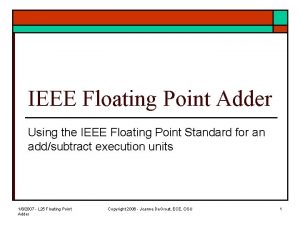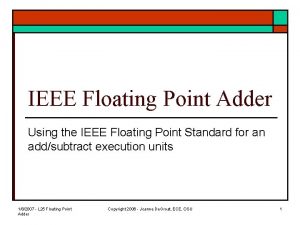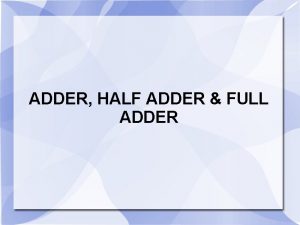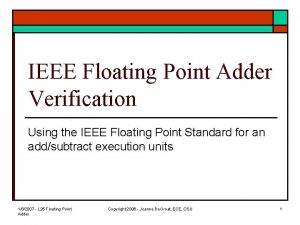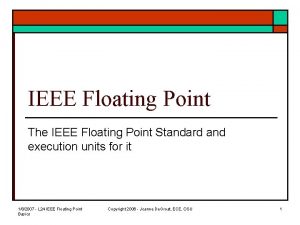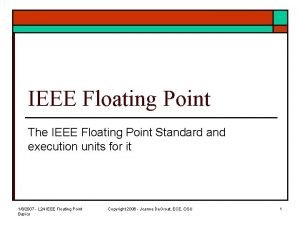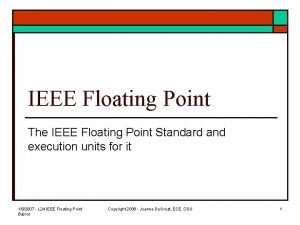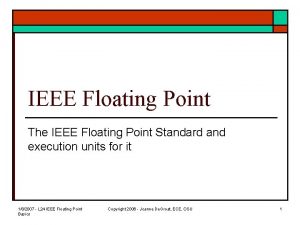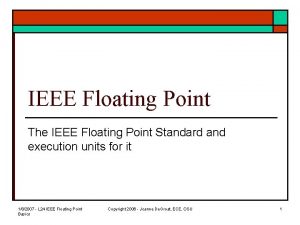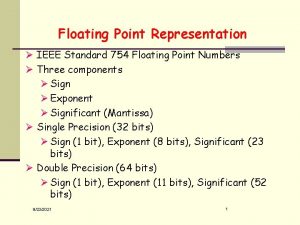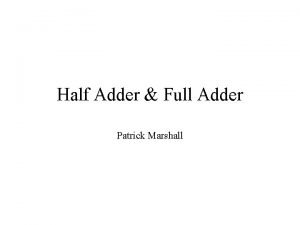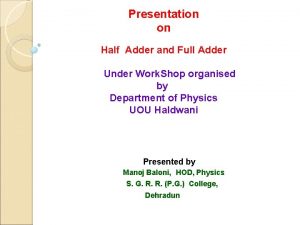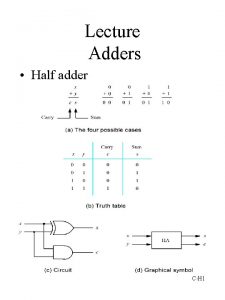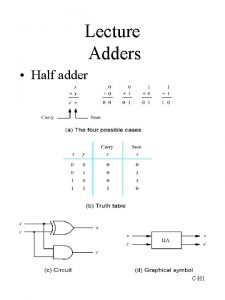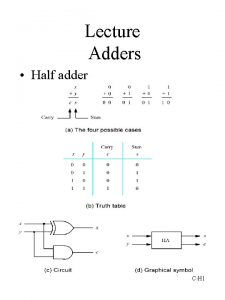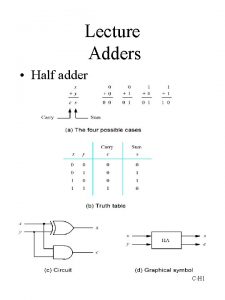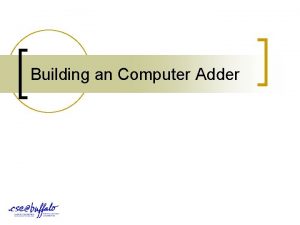IEEE Floating Point Adder Using the IEEE Floating








































- Slides: 40

IEEE Floating Point Adder Using the IEEE Floating Point Standard for an add/subtract execution unit 1/8/2007 - L 25 Floating Point Adder Copyright 2006 - Joanne De. Groat, ECE, OSU 1

Lecture overview o o o The Interface Part by part A floating point adder design 1/8/2007 - L 25 Floating Point Adder Copyright 2006 - Joanne De. Groat, ECE, OSU 2

Adder is double precision o Double Precision o Value of bits in word representation is: n n n If e=2047 and f /= 0, then v is Na. N regardless of s s If e=2047 and f = 0, then v = (-1) ¥ s e-1023 If 0 < e < 2047, then v = (-1) 2 (1. f) o n s If e = 0 and f /= 0, the v = (-1) 2 -1022 (0. f) o n – normalized number Denormalized numbers – allow for graceful underflow s If e = 0 and f = 0 the v = (-1) 0 (zero) 1/8/2007 - L 25 Floating Point Adder Copyright 2006 - Joanne De. Groat, ECE, OSU 3

Specification of a FPA o o Floating Point Add/Subtract Unit Specification n Inputs in IEEE 754 Double Precision Must perform both addition and subtraction Must handle the full floating point standard o o 1/8/2007 - L 25 Floating Point Adder Normalized numbers Not a Numbers – Na. Ns +/- Infinity Denormalized numbers Copyright 2006 - Joanne De. Groat, ECE, OSU 4

Specifications continued n n Result will be a IEEE 754 Double Precision representation Unit will correctly handle the invalid operation of adding + ¥ and - ¥ = Nan per the standard Unit latches it inputs into registers from parallel 64 -bit data busses. There is a separate signal line that indicates the operation add or subtract 1/8/2007 - L 25 Floating Point Adder Copyright 2006 - Joanne De. Groat, ECE, OSU 5

Specifications continued o Outputs n n The correctly represented result Flags that are output are o o o o 1/8/2007 - L 25 Floating Point Adder Zero result Overflow to infinity from normalized numbers as inputs Na. N result Overshift (result is the larger of the two operands) Denormalized result Inexact (result was rounded) Invalid operation for addition Copyright 2006 - Joanne De. Groat, ECE, OSU 6

High level block diagram o Basic architecture interface n n Data – 64 bit A, B, & C Busses Control signals – Latch, Add/Sub, Asel, Drive Condition Flags Output – 7 Flag signals Clocks – Phi 1 and Phi 2 (a 2 phase clocked architecture 1/8/2007 - L 25 Floating Point Adder Copyright 2006 - Joanne De. Groat, ECE, OSU 7

Start the VHDL o The entity interface 1/8/2007 - L 25 Floating Point Adder Copyright 2006 - Joanne De. Groat, ECE, OSU 8

Basic design o o Can be divided into functional sub-blocks First latch and drive 1/8/2007 - L 25 Floating Point Adder Copyright 2006 - Joanne De. Groat, ECE, OSU 9

What goes in the other blocks o o Adjusting the inputs to prepare to add Then renormalize Finally round result 1/8/2007 - L 25 Floating Point Adder Copyright 2006 - Joanne De. Groat, ECE, OSU 10

VHDL coding for the latched o o o A first cut The input latches Note 2 phase 1/8/2007 - L 25 Floating Point Adder Copyright 2006 - Joanne De. Groat, ECE, OSU 11

And on the output o o Drivers Note use of guarded blocks 1/8/2007 - L 25 Floating Point Adder Copyright 2006 - Joanne De. Groat, ECE, OSU 12

And what goes in between? o o In the final design, lots goes in between, but You first want to make sure that the latches are working properly So just pass one input to the output and check And once this works properly can move on with the design 1/8/2007 - L 25 Floating Point Adder Copyright 2006 - Joanne De. Groat, ECE, OSU 13

The first section o o Prepare to add Identify type of inputs and appropriately adjust operands 1/8/2007 - L 25 Floating Point Adder Copyright 2006 - Joanne De. Groat, ECE, OSU 14

The exponent unit portion o o o Must get the larger exponent And the difference between the exponents which is the shift distance Also several control signals n n Exponent all 0 s and all 1 s Exponent A>B, A<B, = 1/8/2007 - L 25 Floating Point Adder Copyright 2006 - Joanne De. Groat, ECE, OSU 15

Mantissa Processing Logic o o Need to examine the two fractional parts and generate several control signals that are required to prepare the operands Need relational signals M>, M=, M< n o Needed to know which operand to shift Need to know if stored fractional part if all 0’s or not n Needed for Na. N, 0, ¥ and determination 1/8/2007 - L 25 Floating Point Adder Copyright 2006 - Joanne De. Groat, ECE, OSU 16

After generating control signals o o Step 1 is to select between a normalized mantissa and a denormalized mantissa For normalized – Prepend NOT(Ex 0) n n o If Ex 0 is a 1 then the exponent if all 0 s and you have a denormalized number or 0 When Ex 0 is a 0 you have a Na. N, infinity, or a normalized number Other selection is the factional part shifted left by 1 and postpended by a 0 n n For denormalized numbers Taking it from 2 -126 to 2 -127 and can now treat it like a normalized number 1/8/2007 - L 25 Floating Point Adder Copyright 2006 - Joanne De. Groat, ECE, OSU 17

Now select between these two o Select the denormalized n n n o WHEN Ex 0 * (NOT Mx 0) When Ex 0 is a 1 you have a denormalized number or 0 When Mx 0 is a 0 there is a least 1 bit of the fractional part that is a 1 and thus you have a denormalized number Select the Na. N, infinity, 0, normalized number n n n Select this case when Ex 0 is a 0 or Mx 0 is a 1 When Mx 0 is a 1 have infinity, 0, or a normalized number When Ex 0 is a 0 have a normalized number, infinity, or Na. N 1/8/2007 - L 25 Floating Point Adder Copyright 2006 - Joanne De. Groat, ECE, OSU 18

Shown in table form ? ? skip o o Selection table to also point out this relationship Note that for a 0 have NOT(Ex 0) prepended to the fractional part or a 0. 00000… 000 1/8/2007 - L 25 Floating Point Adder Copyright 2006 - Joanne De. Groat, ECE, OSU 19

Selections are input to a crossbar o o o The crossbar switch place the larger value on the right path and the small onto the left path The small is the operand to shift if any shifting to align the binary point is needed The equation for exchange on the crossbar is n E> + (E=*M>) or shift the A input to the right side if the exponent of A is the larger OR the exponents are equal and the fractional part of A is larger 1/8/2007 - L 25 Floating Point Adder Copyright 2006 - Joanne De. Groat, ECE, OSU 20

The next multiplexers o o o Now have the smaller on the left path and the larger on the right path. On the left path if either exponent is all 1 s then that operand is Na. N or infinity and has been crossbarred, or is equal, to the right path operand. In this case want to simply pass it through to the output by adding 0 to it. So a 0 is one choice of the left path mux. On the right path select the right path value or mux in a hardwired Na. N for an illegal operation 1/8/2007 - L 25 Floating Point Adder Copyright 2006 - Joanne De. Groat, ECE, OSU 21

Linear shifting o o o Next step is to linear shift the left operand The exponent generates the exponent > signals by subtracting the exponents Exp. A-Exp. B and Exp. B-Exp. A Then with the help of the all control signals the exponent difference is known and this value is sent to the shifter. 1/8/2007 - L 25 Floating Point Adder Copyright 2006 - Joanne De. Groat, ECE, OSU 22

One last mulitplexer o o The right path operand, the larger is simply input to the ADDER. On the left path the output of the linear shifter is sent to the ADDER for a + operation OR The one’s complement of the value is sent to the ADDER for a – operation. In this case the input carry is handled appropriately. 1/8/2007 - L 25 Floating Point Adder Copyright 2006 - Joanne De. Groat, ECE, OSU 23

Code for this section - behavioral o Most of code is generation of various signals and movement of data in muxes 1/8/2007 - L 25 Floating Point Adder Copyright 2006 - Joanne De. Groat, ECE, OSU 24

Xbar code highlight o Code n n n swap <= expgt OR (expeq AND mangt); xbar_r <= lxbarin when (swap = ‘ 1’) else rxbarin; xbar_l <= rxbarin when (swap = ‘ 1’) else lxbarin; 1/8/2007 - L 25 Floating Point Adder Copyright 2006 - Joanne De. Groat, ECE, OSU 25

Hard code Na. N VHDL code o The code n n -- Control equation for mux in_mux_r_man <= expa 1 AND mana 0 and expb 1 AND manb 0 and (signa XOR signb); in_mux_r <= nan_man WHEN (in_mux_r_man = ‘ 1’) ELSE xbar_r; 1/8/2007 - L 25 Floating Point Adder Copyright 2006 - Joanne De. Groat, ECE, OSU 26

Now add the mantissas o o o Simply add the two mantissas. As the sign of the B input was XORed with the operation, i. e. , inverted if it was a subtract operation, the carry in the XOR of the two signs. If the signs are different then a subtract is being performed and a ‘ 1’ if being input to the carry in of the adder. The adder does two’s complement addition. Inputs are of the form x. xxxxx…xx or 54 bits. The output is of the form xx. xxxx…xxx or 58 bits 1/8/2007 - L 25 Floating Point Adder Copyright 2006 - Joanne De. Groat, ECE, OSU 27

On to the next challenge o o o This is perhaps the hardest part – renormalization of the result Have a result exponent (the exponent of the larger) and a mantissa in the form xx. xxxxxx…xxxx The following slide shows the processing needed 1/8/2007 - L 25 Floating Point Adder Copyright 2006 - Joanne De. Groat, ECE, OSU 28

Renormalization Unit o Have exponent and mantissa to deal with. 1/8/2007 - L 25 Floating Point Adder Copyright 2006 - Joanne De. Groat, ECE, OSU 29

Many choices to deal with o o o May need to shift the mantissa 1 position to the right on a fixed binary point. May be OK as is May have to shift left – then need to know the position of the leading 1. n n In a behavioral model can simply shift left once, increment a counter and then check. In hardware need a leading 1 detector that give the position of the leading 1 so that the mantissa can be shifter left. 1/8/2007 - L 25 Floating Point Adder Copyright 2006 - Joanne De. Groat, ECE, OSU 30

Interactions o o All shifts of mantissa result in exponent adjustment. There are 4 choices on the exponent n n As is Incremented by 1 Adjusted down by some amount depending on shift Zero 1/8/2007 - L 25 Floating Point Adder Copyright 2006 - Joanne De. Groat, ECE, OSU 31

Interactions o There are 5 choices on the mantissa n n n o As is Right shifted by 1 – increment exp by 1 Left shifted for leading 1 Left shifted and then right shifted by 1 Hardwired 0 This part is the same for both addition and multiplication. Easy to do algorithmically. 1/8/2007 - L 25 Floating Point Adder Copyright 2006 - Joanne De. Groat, ECE, OSU 32

Rounding Unit o o o Once done with renormalization will look at the guard bits to determine rounding. Standard specifies several rounding modes. Can also just truncate. 1/8/2007 - L 25 Floating Point Adder Copyright 2006 - Joanne De. Groat, ECE, OSU 33

Rounding o o Can result in changes to both the mantissa and the exponent. After rounding final result is output in normalized form. 1/8/2007 - L 25 Floating Point Adder Copyright 2006 - Joanne De. Groat, ECE, OSU 34

And don’t forget the flags o o Any arithmetic unit output flags on the status and validity of the result. The flags to be generated are output from various control signals or combinations of various control signals. 1/8/2007 - L 25 Floating Point Adder Copyright 2006 - Joanne De. Groat, ECE, OSU 35

To test (verify) the design o o Must test for normal operation and boundary conditions Will check A by B n n n o Na. N +/- infinity +/- 0 Denorm Norm For both direct and all crossed pairings 1/8/2007 - L 25 Floating Point Adder Copyright 2006 - Joanne De. Groat, ECE, OSU 36

Boundary conditions o Wish to check several boundary conditions n n n n Denorm + Denorm = Max Denorm + Denorm = Min Norm – Norm = Max Denorm … Rounding using first guard bit Rounding using 1 st and 2 nd guard bits … 1/8/2007 - L 25 Floating Point Adder Copyright 2006 - Joanne De. Groat, ECE, OSU 37

Testing o o Testing of the design code is not necessarily the same as the testing the would be done on the chip. The “testing” of the design is call verification and must insure that all possible input combinations produce the specified output. 1/8/2007 - L 25 Floating Point Adder Copyright 2006 - Joanne De. Groat, ECE, OSU 38

Scan of entire architecture 1/8/2007 - L 25 Floating Point Adder Copyright 2006 - Joanne De. Groat, ECE, OSU 39

Scan of the chip 1/8/2007 - L 25 Floating Point Adder Copyright 2006 - Joanne De. Groat, ECE, OSU 40
 Compound adder
Compound adder Floating point single precision
Floating point single precision Fixed point representation vs floating point
Fixed point representation vs floating point Fp adder
Fp adder Signed number range
Signed number range Floating point number representation
Floating point number representation Load float mips
Load float mips Floating point operations per seconds
Floating point operations per seconds Floating point number representation
Floating point number representation Floating point denormalized
Floating point denormalized Floating point
Floating point Floating point representation
Floating point representation Floating-point number
Floating-point number Fp adder hardware
Fp adder hardware Eascii
Eascii Parts of a floating point number
Parts of a floating point number Integer pipeline stages of pentium processor
Integer pipeline stages of pentium processor Xkcd floating point
Xkcd floating point Dfa for floating point numbers
Dfa for floating point numbers Floating point representation adalah
Floating point representation adalah Xkcd discussion
Xkcd discussion Express (32)10 in the revised 14-bit floating-point model
Express (32)10 in the revised 14-bit floating-point model Floating point form
Floating point form Floating point puzzles
Floating point puzzles Floating point puzzles
Floating point puzzles Integer
Integer 4 bit two's complement
4 bit two's complement Number system
Number system Vhdl code for serial adder
Vhdl code for serial adder 175 =
175 = Rangkaian aritmatika
Rangkaian aritmatika 4 bit parallel adder truth table
4 bit parallel adder truth table 4 bit carry look ahead adder
4 bit carry look ahead adder Half subtractor
Half subtractor What equals 9 in addition
What equals 9 in addition Rangkaian adder yang menjumlahkan banyak bit disebut *
Rangkaian adder yang menjumlahkan banyak bit disebut * Compound adder
Compound adder Sommatori logici
Sommatori logici Bcd adder vhdl
Bcd adder vhdl Qc.measure qiskit
Qc.measure qiskit Carry select adder
Carry select adder
